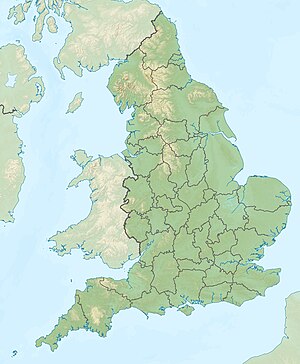Corfe Castle
| Corfe Castle | ||
|---|---|---|
|
The castle ruins |
||
| Creation time : | 9th century | |
| Conservation status: | ruin | |
| Geographical location | 50 ° 38 '25 " N , 2 ° 3' 35" W | |
|
|
||
Corfe Castle is the ruin of a castle in the English town of Corfe Castle in the county of Dorset . The ruin, classified as a Grade I cultural monument and protected as a Scheduled Monument , is located in the Purbeck Hills on the Isle of Purbeck seven kilometers southeast of Wareham and eight kilometers west of Swanage . It is approximately 12 km southwest of the major cities of Poole and Bournemouth .
Surname
The name Corfe comes from Anglo-Saxon and describes the valley in which the village and the castle ruins are located. Corfe Castle means roughly Talburg or castle in the valley .
history
Saxon settlement
Under Alfred the Great at the end of the 9th century, a first fortification was built in Corfe to protect against the Danes . According to legend, the English King Edward the Martyr was murdered in the castle on March 18, 978.
Construction of the castle in the Middle Ages
After the Norman conquest of England , around 1090 the Normans began building a castle from local limestone on the site of the old fortification. Under Henry I. "Beauclerc" the mighty Keep was built around 1105 . At the beginning of the anarchy , the castle, which was defended by Baldwin de Redvers , was unsuccessfully besieged by King Stephen in 1139 . The castle was expanded under King Johann Ohneland . He stayed in the castle frequently, and also used it as a repository for the crown jewels and as a prison . In 1202 there was an escape attempt by 25 French knights who had been captured during the Franco-English War . However, they could only occupy the keep, in which they would rather starve than surrender. 22 of the knights died, only three survivors were ultimately overwhelmed. John's niece Eleanor of Brittany and King Edward II in the 14th century were also imprisoned in Corfe Castle. The outer courtyard was completed under Edward I. In the 14th century the castle was initially neglected until Edward III. had it repaired between 1356 and 1377. After the Wars of the Roses , Henry VII had it expanded as a residence for his mother Margaret Beaufort . After their death, the castle fell back to the crown. In 1572 Elizabeth I sold it to her future Lord Chancellor Christopher Hatton , who further fortified the castle in view of the threat from the Spanish Armada . In 1635 Sir John Bankes , who later became Chief Justices of the Common Pleas , acquired the castle.
English Civil War
In 1643, during the English Civil War , the castle of parliamentarians ( "was of troops Roundheads ") besieged . Under the orders of the royalist Lady Mary Bankes , the castle withstood the siege for six weeks, after which the parliamentarians withdrew with the loss of 100 men. Three years later, in 1646, the castle was besieged a second time. After a two-month siege, the castle garrison was betrayed by one of its members in February 1646. After the takeover by the parliamentarians, the Bankes family was allowed to leave the castle. The castle was then destroyed by sappers with explosives , which led to the appearance of the castle complex today. The local population took advantage of this and used the stones and other materials from the castle to build their nearby houses.
Modern times
After the Civil War, Ralph Bankes built Kingston Hall at Wimborne Minster in 1663 as the new family home. The remains of Corfe Castle remained in the hands of the Bankes family until 1982, when Ralph Bankes left them to the National Trust . After the donjon was in danger of collapsing in 2006, the upper ruins can now be viewed again.
Tourism and infrastructure
The castle is owned by the National Trust, which has also set up a gift shop in the market square . In 2002 the castle, which is open to tourists all year round, counted 167,582 visitors.
On the market square of Corfe Castle, the Corfe Model Village with a replica of the castle and the village stands before destruction on a scale of 1:20. It was created by Eddie Holland from 1964 to 1966.
Corfe Castle in the film
The ruin served u. a. as a backdrop for the television series The Treasure Island thing , which was filmed in 1957 based on motifs from the children's book series Five by Enid Blyton , and for the 2008 film adaptation of the novel Tess von den d'Urbervilles .
literature
- Emmeline Hardy: The Story of Corfe Castle. Dovecote Press, Stanbridge / Wimborne / Dorset 1988, ISBN 0-946159-50-5 .
- National Trust: Corfe Castle - 1000 years of history. Paragon Press, London 1987.
Notes and sources
- ^ British Listed Buildings: Corfe Castle, Corfe Castle. Retrieved January 21, 2015 .
- ^ National Trust: The death of Edward the Martyr at Corfe Castle. Retrieved January 20, 2015 .
- ↑ Wilfred L. Warren: King John . University of California Press, Berkeley, 1978, ISBN 0-520-03494-5 , p. 81
- ↑ The source for this figure is the National Trust Annual Report 2004/05
- ↑ IMDb: The thing with Treasure Island (1957). Retrieved December 29, 2014 .
- ^ IMDb: Tess of the D'Urbervilles (2008). Retrieved December 29, 2014 .
Web links
- Corfe Castle on the website of the National Trusts (English)
- Corfe Castle on the website of the Isle of Purbeck ( Memento from February 9, 2017 in the Internet Archive )
- Site Castle and village (English)
- Information (English)




